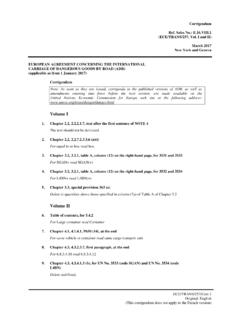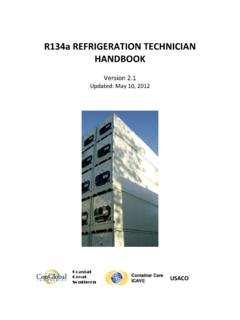Transcription of STUDENT WORKBOOK - dothazmat.vividlms.com
1 PLACARDING. STUDENT WORKBOOK . Table of Contents Table of Contents .. 2. Module 4: Placarding .. 4. 4. 4. 4. General Rule for Placarding .. 4. Placarding Applicability .. 4. Prohibited Placarding .. 5. Exceptions to Prohibited Placarding .. 5. Introduction .. 5. General Placarding Requirements .. 5. Placarding Table 1 .. 6. Division Exceptions .. 7. Division Exceptions .. 7. Poison Gas and Poison Hazard .. 8. Class 7 Radioactive Exceptions .. 8. Placarding Table 2 .. 8. Table 2 Placarding 9. Other Class Exceptions .. 10. Additional Requirements .. 10. Use of Dangerous Placard .. 10. Dangerous Placard Exceptions.
2 11. Placarding for Subsidiary Hazards .. 11. Dangerous When 12. Providing and Affixing .. 12. Providing and Affixing Placards .. 12. Special Placarding Provisions .. 12. Freight Containers and Aircraft Unit Load Devices More than 640 Cubic Feet .. 13. Freight Containers and Aircraft Unit Load Devices Less than 640 Cubic Feet .. 14. Bulk Packages .. 14. Visibility and Display of Placards .. 15. Specifications for Placards .. 16. Placarding: Gallery .. 17. Placard Gallery .. 17. DANGEROUS Placards .. 17. EXPLOSIVES Placards .. 18. GAS Placards .. 19. FLAMMABLE and COMBUSTIBLE Placards .. 20. FLAMMABLE SOLID, SPONTANEOUSLY COMBUSTIBLE, and DANGEROUS WHEN WET Placards.
3 21. "OXIDIZER" and "ORGANIC PEROXIDE" Placards .. 21. "POISON" and "POISON INHALATION HAZARD" Placards .. 22. RADIOACTIVE Placard .. 23. CORROSIVE 23. Class 9 Placard .. 23. Summary .. 25. References .. 25. Module 4: Placarding Placarding When an accident causes hazardous materials in transportation to be released, the vehicle operator, emergency response teams, and the surrounding community all face imminent danger. Emergency response teams must accurately identify materials as quickly as possible. To aid emergency response teams, DOT developed a system of placarding for the rapid identification of hazardous materials.
4 Emergency responders are trained to look for warning placards. Improperly placarded or unplacarded hazmat shipments place the lives of individuals and others at risk. This module will review how placards are used to communicate valuable information to emergency responders, and others who deal with materials on a daily basis. Objectives 1. Identify the requirements for placarding, and any exceptions or modifications allowed with these requirements. 2. Examine the two placarding tables in section (e) to determine placarding requirements. 3. Identify the requirements for placard placement, visibility, and design.
5 General Rule for Placarding The general rule to apply when determining the placarding requirements for hazardous materials is simple if a hazardous material is contained within a transport vehicle, bulk packaging, freight container, unit load device, or rail car, then a placard representing the hazard class for the hazardous material must be displayed on both sides and at each end regardless of the quantity. The regulations allow other approaches to placarding under specific circumstances. These are exceptions to this basic rule. Placarding Applicability If you offer for transportation or transport any hazardous material subject to the HMR, you must comply with the applicable placarding requirements of Part 172 Subpart F Placarding.
6 Placards are placed on bulk packagings, freight containers, transport vehicles, and rail cars to alert the public of the potential dangers of the product being transported and to guide emergency responders in the event of an incident or accidental release. 4|P a g e Hazardous Materials Regulations Placarding STUDENT WORKBOOK One set of the exceptions to these placarding requirements provided for in the HMR involves the seven groups of materials listed here: 1. Division Infectious substances 2. Hazardous materials renamed as consumer commodities and reclassed as ORM-D [ORM-D will be phased out by December 31, 2020.]
7 ]. 3. Hazardous materials offered for transportation as Limited Quantity material when identified as such on a shipping paper or by marking on a package 4. Hazardous materials prepared in accordance with sections 5. Hazardous materials packaged as small quantities in accordance with sections , , and Prohibited Placarding No person may affix or display on a packaging, freight container, unit load device, motor vehicle or rail car any placard described in the HMR unless: The material being offered or transported is a hazardous material The placard represents a hazard of the hazardous material being offered or transported The placarding conforms to the requirements of the HMR.
8 Additionally, any sign, advertisement, slogan (such as "Drive Safely"), or device that, by its color, design, shape or content, could be confused with any placard prescribed in the HMR is prohibited. Exceptions to Prohibited Placarding These restrictions do not apply to a bulk packaging, freight container, unit load device, transport vehicle or rail car that is placarded in conformance with: The Transportation of Dangerous Goods (TDG) Regulations The International Maritime Dangerous Goods (IMDG) Code The United Nations (UN) Recommendations These restrictions also do not apply to the display of a BIOHAZARD marking, a HOT marking, a sour crude oil hazard marking, or an identification number on a white square-on-point configuration in accordance with the HMR.
9 General Placarding Requirements For each bulk packaging, freight container, unit load device, transport vehicle or rail car containing any quantity of a hazardous material, you must placard each side and each end with the type of placards specified in Tables 1 and 2 of section and in accordance with other placarding requirements of the HMR, unless a specific placarding exception is provided for that quantity of material or hazard class 5|P a g e Hazardous Materials Regulations Placarding STUDENT WORKBOOK or division. Do not confuse these two placarding tables with the Hazardous Materials Table found in section When determining which placards must be used and what options are available, both placarding tables must be considered.
10 You may placard a hazardous material shipment, even when an exception makes it unnecessary, if the placarding otherwise conforms to the requirements of the HMR for the hazards presented. Placarding Table 1. Table 1 lists hazardous materials by category for which placarding is required for any quantity of material contained in the freight container, unit load device, transport vehicle, or rail car. No material, for which Table 1 applies, is duplicated in Table 2. Each material will be exclusive to only one of the two tables. Placarding requirements for hazard class or division numbers and are divided between Table 1 and Table 2 based on additional description information.







